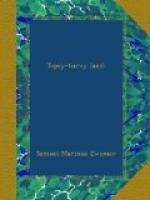II
A LESSON IN GEOGRAPHY
In the atlas Arabia looks like a big mail-pouch hung up by the side of some railway station, pretty empty of everything. But this queer mail-pouch country is not as empty as people imagine. It is a country larger than all of the United States east of the Mississippi. It is longer than the longest mail-pouch and much wider. From north to south you can ride a camel one thousand miles and from east to west more than six hundred. But the geography of the country is topsy-turvy altogether and that is why it has been so long a neglected peninsula. People kept on wondering at the queer exterior of the mail-pouch and never opened the lock to its secrets by looking into the interior.
First of all, Arabia is perhaps the only land that has three of its boundaries fixed and the other always shifting. Such is the case with the northern boundary of Arabia. It is different on every map and changes every year because the inhabitants go about as nomads; that is, they “have no continuing city.”
Arabia has no rivers except underground. It has no railroad and very few roads at all. Some parts of the country are very green and fertile and in other parts there is not enough grass the year around to give one square meal to a single grasshopper. Arabia has four thousand miles of coast and yet only six harbours where steamers call. There are better maps of the North Pole and of Mars and of the moon than of southeastern Arabia. The reason is that men have spent millions of dollars to find the North Pole and telescopes are all the time looking at the moon; but no one has ever spent time or money to explore this part of Arabia. The Greek geographers had a better knowledge of Arabia than we have to-day.
[Illustration: MAP OF ARABIA.]
There are no lakes in Arabia, but there is a large sea of sand called Al Ahkaf, in which the traveller Von Wrede threw a lead and line and found no bottom! No one has been there since to see whether his story was true. At Bahrein, in eastern Arabia, there are salt-water wells on shore and fresh-water springs in the midst of the salt sea from which water is brought to shore. Arabia has no postage-stamps and no political capital and no telegraph system. Different coins from different parts of the world are used in different provinces. It is a land of contradictions and even the waters that bound it are misnamed. The Red Sea is blue; the Persian Gulf has no Persian ships and should be called an English lake; and the Straits of Hormuz are crooked. This topsy-turvy land has no political divisions. Some say it has five and some seven provinces; no one knows what is its population as no census was ever taken. In nearly all countries the mountain ranges run north and south, but in Arabia they run nearly east and west. There are desert sands six hundred feet deep and mountain peaks nine thousand feet high. On the coasts it is fearfully hot and the climate is often deadly. On the highlands it is often bitterly cold; and yet the people are all of the same race and speech and custom and language and religion.




